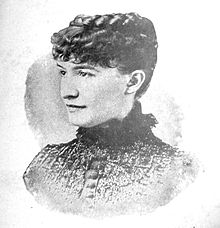Mary Noailles Murfree
| Mary Noailles Murfree | |
|---|---|
 |
|
| Born | Mary Susan Murfree January 24, 1850 near Murfreesboro, Tennessee |
| Died | July 31, 1922 (aged 72) Murfreesboro, Tennessee |
| Resting place | Evergreen Cemetery, Murfreesboro |
| Pen name | Charles Egbert Craddock |
| Occupation | Writer |
| Language | English |
| Nationality | United States |
| Period | 1884–1914 |
| Subject | Appalachian life |
| Relatives | Colonel Hardy Murfree (grandfather) |
Mary Noailles Murfree (January 24, 1850 – July 31, 1922) was an American fiction writer of novels and short stories who wrote under the pen name Charles Egbert Craddock. She is considered by many to be Appalachia's first significant female writer and her work a necessity for the study of Appalachian literature, although a number of characters in her work reinforce negative stereotypes about the region. She has been favorably compared to Bret Harte and Sarah Orne Jewett, creating post-Civil War American local-color literature.
The town of Murfreesboro, Tennessee, is named after Murfree's great-grandfather Colonel Hardy Murfree, who fought in the Revolutionary War.
Murfree was born on her family's cotton plantation, Grantland, near Murfreesboro, Tennessee, a location later celebrated in her novel, Where the Battle was Fought and in the town named after her great-grandfather, Colonel Hardy Murfree. Her father was a successful lawyer of Nashville, and her youth was spent in both Murfreesboro and Nashville. From 1867 to 1869 she attended the Chegary Institute, a finishing school in Philadelphia. Murfree would spend her summers in Beersheba Springs. For a number of years after the Civil War the Murfree family lived in St. Louis, returning in 1890 to Murfreesboro, where she lived until her death.
Being lame from childhood, Murfree turned to reading the novels of Walter Scott and George Eliot. For fifteen successive summers the family stayed in Beersheba Springs in the Cumberland Mountains of Tennessee, giving her the opportunity to study the mountains and mountain people more closely.
...
Wikipedia
